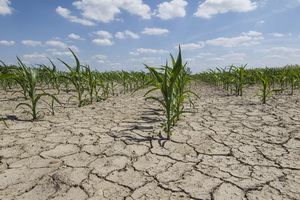
ERS Publishes Report on Development, Adoption, and Management of Drought Tolerant Corn in the United States
February 20, 2019| |
 A new report published by the U.S. Department of Agriculture Economic Research Service (USDA ERS) and authored by Jonathan McFadden, David Smith, Seth Wechsler, and Steven Wallander discusses the adoption and use of drought tolerant (DT) corn in the United States.
A new report published by the U.S. Department of Agriculture Economic Research Service (USDA ERS) and authored by Jonathan McFadden, David Smith, Seth Wechsler, and Steven Wallander discusses the adoption and use of drought tolerant (DT) corn in the United States.
Droughts have been among the significant causes of yield reductions and losses for centuries. Conventionally bred drought tolerant corn was commercially introduced in the United States in 2011, while genetically engineered (GE) corn in 2013. Majority of DT corn planted in 2016 had one or more GE traits such as herbicide tolerance and/or insect resistance.
The report concludes that over one-fifth of U.S. corn acreage was planted with DT corn in 2016. DT corn accounted for only 2 percent of U.S. planted corn acreage in 2012, but this grew to 22 percent in 2016. The researchers also found that the pace of adoption is similar to the adoption of herbicide-tolerant corn in the early 2000s. At least 80 percent of DT corn acres were planted in 2016 with seed conventionally bred for drought tolerance, while 20 percent was planted with GE seeds. At the national level, 3 percent of all U.S. corn acres in 2016 were planted with seed that had been genetically engineered for drought tolerance.
For more details, download and read the report from the ERS website.
| |
Biotech Updates is a weekly newsletter of ISAAA, a not-for-profit organization. It is distributed for free to over 22,000 subscribers worldwide to inform them about the key developments in biosciences, especially in biotechnology. Your support will help us in our mission to feed the world with knowledge. You can help by donating as little as $10.
-
See more articles:
-
News from Around the World
- Hunger in Africa Continues to Rise, UN Report Reveals
- New Biotech Cotton Event Approved in Argentina
- Epigenetics Research Could Lead to More Resilient Crops
- ERS Publishes Report on Development, Adoption, and Management of Drought Tolerant Corn in the United States
- Battle to Save the US Citrus Industry Hinges on Consumer Acceptance of GM Food
- SEARCA BIC Policy Brief Highlights Global Scientific Consensus on the Safety of GMO Technology
- New Evidence on Vernalization Has Been Found
- Wageningen Economic Research Conducts Comparative Analysis of Global Agricultural Policies for the EU
-
Research Highlights
- Overexpression of OsFTL10 Induces Early Flowering Improves Drought Tolerance in Rice
- Co-expression of Soybean Genes Leads to Improved Folate Content in Maize and Wheat
-
Announcements
- Global Congress on Biotechnology
-
Resources
- Gene Editing: A Potential GameChanger for Crop Agriculture
- ISAAA in 2018: Accomplishment Report
-
Plant
- CRISPR-Cas9 Mutations in a Rice Gene Changes Starch Biosynthesis in the Endosperm
- Transgene-Free Genome Editing in Tomato and Potato Plants Using CRISPR-Cas9 Cytidine Base Editor
-
Read the latest: - Biotech Updates (December 10, 2025)
- Gene Editing Supplement (November 26, 2025)
- Gene Drive Supplement (February 22, 2023)
-
Subscribe to BU: - Share
- Tweet
